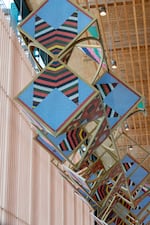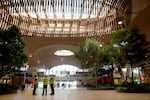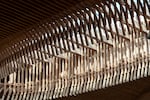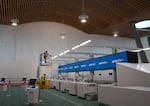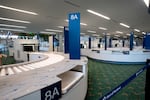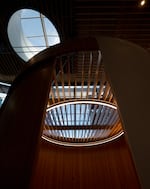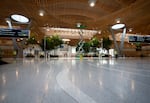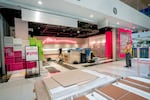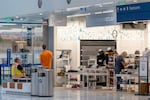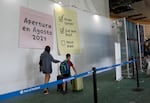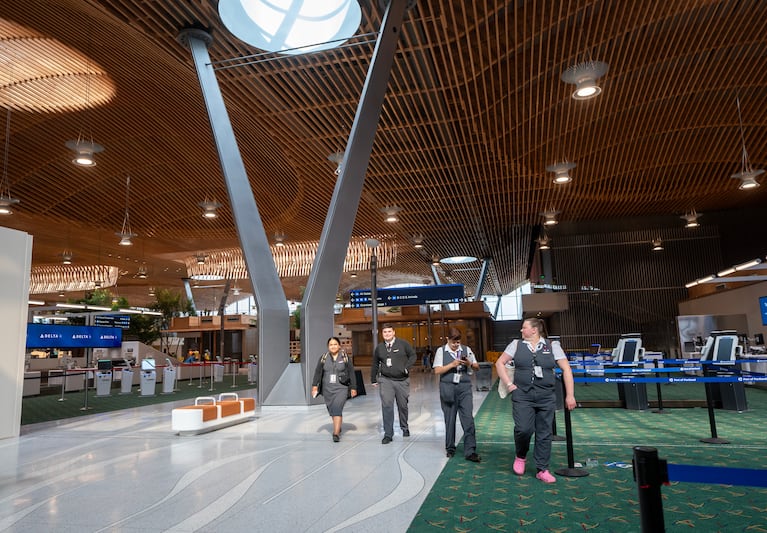
Airline staff walk through the new main terminal at the Portland International Airport, Aug. 2, 2024. The next milestone in the $2.15 billion expansion will happen on Aug. 14, when the new main terminal will be opened to the public.
Kristyna Wentz-Graff / OPB
The largest public works project in Oregon history is coming to completion. After four years of construction and a little more than $2 billion, the Portland International Airport’s new terminal is open to the public.
The main terminal remodel features skylights made of local Douglas fir, the return of the beloved original carpet and a 120-foot-long video wall that serves as a 24-hour art installation. This opening is just one phase with more to come in December 2025.
Curtis Robinhold is the executive director of the Port of Portland. He gave us a sneak peek of the terminal in late July to share the thinking behind the architecture, the indoor tree garden and more.
Note: This transcript was computer generated and edited by a volunteer.
Dave Miller: This is Think Out Loud on OPB, I’m Dave Miller. A big piece of the most expensive public building project in Oregon history is complete. The remodeled main terminal of the Portland International Airport opened today. 30,000 people worked on the $2 billion project. We got a sneak peak of the terminal a few weeks ago when the final touches were being completed – folks were planting trees, operating heavy machinery and vacuuming the floors.
Curtis Robinhold was our guide. He is the executive director of the Port of Portland. I started by asking if he could just describe where we were.
Curtis Robinhold: We are in the new airport terminal at PDX International Airport. It’s a project that’s been going on for about seven years, a $2 billion project, the largest public works project in Oregon history with about 30,000 people having contributed to this work. We are in what used to be the Oregon Market, and is now part of a vast new complex, roughly doubled in size, that was really designed to address issues of flexibility in the space, volume, how many people come through the airport every day, and the constraint we used to have around security in particular, but also around seismic resilience.
Miller: Let’s dig into this. What were the reasons for embarking on this, the largest public works project in Oregon history - over $2 billion?
Robinhold: That’s right.
Miller: Why did you need to do this?
Robinhold: The original airport here – out near the Columbia River, built on sand – was opened in 1956 and essentially had no more capacity to grow. We were running pre-pandemic at about 20 million passengers a year, and our master planning process showed us that we were going to be hitting 35 million in a 10 or 20 year period. We needed more capacity. In order to get that capacity here in the structure, we had to essentially break it open. There was no way to keep adding little pieces here and there. It was a broader building code requirement to get up to building code and to be seismically resilient.
So we knew we had to do the work. The real question is, what do you do once you know you have to do the work? And that’s where the fun began.
Miller: Was it a question of managing people inside, getting them through security or having their bags go where they need to go? Or was it about where are the planes gonna go?
Robinhold: We don’t have a shortage of space for planes. We’ve got plenty of room. We managed that actually through this process. We called the whole project PDX Next, it’s actually five different projects. This is the fifth and last. The constraint is really around how many people you can move through a very narrow security throat. And I know folks who are here in the region are familiar with that. It gets tight, especially in the morning and in the mid-afternoon. We call that a double bump. Essentially, we didn’t have enough bandwidth for the growth that we knew was coming. And that drove a lot of the decision making around, how do you address that concern?
Miller: We’re in the middle of this soon to be opened, big public space. By the time this airs, this will be open. Do you have a favorite part of where we are right now?
Robinhold: The roof is hard to ignore. It’s really spectacular. You’re standing under a nine acre roof made of Douglas fir. Seismically resilient, but I think more interesting and compelling is all of the wood here in the roof comes from within 300 miles of where we’re standing. Sustainably harvested from 11 forest land nonprofit and Tribal owners. And we can tell you from this position where the wood came from, where it originated, and where it was milled, which is a whole new track and trace, is the nomenclature.
But my favorite is this big one in the center, over the trees. I can tell you that the wood here came from the Coquille Nation on the southwest Oregon coast. You see below it is essentially a forest canopy replicated. The idea of our design team was really to have a walk in the woods. And for me, as the executive director at the Port, it was really about having a place you walk into and it feels like home. I’m always struck when I walk into Shanghai Airport or Chicago or Los Angeles, you have no idea where you are. They’re very sterile.
Miller: You’re in kind of international airport land.
Robinhold: Shopping mall land. It doesn’t feel like home. It’s one of the things that we hear about with the carpet, the old carpet in particular, is people look at it and say “I now know I’m home, this is my place.” And so we really wanted to reflect that in the design and in the work, in the art and in the concessions, in everything we did. We wanted it to feel like something people recognized, knew was theirs and that they’d be proud of.
Miller: How many trees are you gonna be planting?
Robinhold: The number of trees I believe is in the 70 range. And they’re not from Oregon, interestingly, because we needed trees that were big enough to fill the space, and also would grow through winter and not lose all their leaves inside.
Miller: If you’re going to evoke home, sometimes you have to cut some botanical corners.
Robinhold: For sure. But this is Doug fir above us, and white oak below us. This white oak is from Rickreall, and all comes from within 60 miles of Salem – the flooring here. So the idea of many of these design elements is to really evoke the local product, also a connection that we have in Oregon between rural and urban, and really to tell a story about this place that we’re in.
Miller: Can you take me to the stadium seating over here?
Robinhold: Sure. So what we’re walking through now is where passengers will flow, as we did in the earlier version of the airport. You flow past ticketing, baggage handling and where you check your bags. And you come into a space where you’ll either head north or south through security. The idea we wanted to evoke after you come through ticketing and you’ve checked your bags is an open space that belongs to the community. We can have events here. I just mentioned that we had our construction team, our architects here last night, and celebrated the opening together. But we have, upstairs, a pre-pandemic bar and restaurant, Loyal Legion, another local brand. And the idea is in this space you have a place where you can come and meet your people. You can come here and rest, or gather your composure before you go through security.
Miller: So that’s an important point – everything that we’re looking at right now, anybody could experience. Why was that important to you, to make this showpiece pre-security?
Robinhold: The pre-security concessions, which are these four sort of boxlike shapes out here also clad in wood, and the restaurant and bar here from Loyal Legion, is all pre security. We wanted it to be a place that’s welcoming to the community and a place where the community felt like they could go. They might even arrive early. I know my family likes to come early and get a bite to eat before going through security. And that’s very unusual in the post-911 airport world, most concessions are now behind security. But I hear a lot from people here in the community who say “we used to go there and watch planes take off, and we love that.” What we’re trying to evoke is a little more of that community feel in a space that really does belong to the community. It’s a public asset. It belongs to the folks who are here in the region.
Miller: So right now, we’re in a kind of a big, almost seems like a performance area, with wooden stadium seating on either side. What’s the idea of this?
Robinhold: The idea of the space here … and if you step this way, we can go up these stairs, Dave.
Miller: [Laughing] You stopped me from stepping where I wasn’t supposed to step.
Robinhold: You’re welcome to step over there, but you can’t get through. That’s my only charge here.
These are from Zena [Forest Products], these big wide oak benches here. The idea is you can come here, and sort of gather your wits about you, get ready for your journey, or wait for people, meet people, meet your family. And folks who are exiting will come through this space. But also we have in mind you could have a grand piano out here, or you could have a Chinese New Year celebration here with the dragon dance. Things that we’ve tried to do in the airport, but would also be available pre-security. Have an art show, have a community meeting out here. The idea is an open space that is welcoming and belongs to the community.
Come on upstairs and we can have a pretty great view out and around from up here. You also get much closer to the roof I mentioned, and these great skylights. There are 49 skylights in the structure that essentially create a lot of daylighting that you wouldn’t otherwise see in an airport, it gets very sort of sanitary.
Here’s a little swath of the old carpet as well so folks can still do their feet selfies.
Miller: It’s been a long time since I saw this carpet, which a lot of people really care about. When did you arrive at the Port?
Robinhold: I arrived at the Port in 2014.
Miller: When was the old carpet removed?
Robinhold: ‘15, so it was a project that was underway when I arrived. We essentially have 14 acres of carpet at the airport. We used to have more, and we’ve changed a bit of that here inside the new terminal. But we didn’t really see that awakening to this carpet style, this sort of teal with what is to represent the former pattern for air traffic controllers of PDX. But now it’s tattoos and the grand marshal of the Rose Festival Parade, it’s everywhere.
Miller: Were you expecting Portland to care as much as they did about the removal of the old carpet?
Robinhold: No, not at all. And I think one of the things that it really evokes, and the thing I hear about, the sort of thinking I have about it myself, is that it is a signal to people that now I’m home. So even if it’s a little bit corny, maybe even a little bit ugly, it’s the place where you say “Yeah, but that’s ours. That’s our ugly.”
Miller: That’s your vote? A little bit ugly, a little bit corny?
Robinhold: It is. But I love it, and people love it.
Miller: What did it take to recreate it? Was there just a huge roll of it somewhere in a warehouse?
Robinhold: I wish there was, because instead we had to have it remade. The carpet that folks know from the existing structure inside the airport was also custom made. This was remade, custom made. We have it in four locations throughout the new terminal, so that folks will be able to come and tweet their feet, sit by it, do whatever you like with it. It was remade. We had gotten rid of all the old swatches to folks in town to make coffee holders, or socks, or whatever was made from the old carpet.
Miller: You seem like you’re done talking about the carpet. [Laughter]
Robinhold: It’s funny, it’s sort of a love/hate relationship with me. I’ve got to say, I was surprised by it. I have worked in both public and private sector, I’d never found something that was so visceral for people, but for kind of humorous, local reasons, not because it stood for something more than “Yeah, it’s ours. We like it.” It’s kind of funny.
Miller: When you were as a team trying to figure out what you were gonna design, how the remodel was gonna work, how much did you think about the fact that for a lot of people, going to airports is just a miserable experience from beginning to end? It’s not about arriving at home or going to some exciting place. It’s about the anxiety of flying, the fear of missing your connection, just being in lines. Not for everybody, but for a lot of people, they do not want to be here. If you’re designing a space, what do you do knowing that many people don’t want to be there?
Robinhold: Maybe, as I respond, I’ll walk you over to the most stressful part.
My wife and I have two young daughters. We travel, and this is the most stressful part of the journey. I’m pointing to TSA and the pass through security. Really what we try to do is manage this process, both by getting new equipment and expanding the space that the equipment sits in to make the flow easier. We also have the carpet in these locations where you’re either standing or sitting. So in the new structure, you’ll see a hard surface where you’re walking and moving and rolling bags and rolling bags. We got great feedback from community groups around accessibility who said rolling bags, a wheelchair, people with mobility issues have a really hard time on the carpet. For parts of the journey, like in security where you wanna lower tension, it’s a good thing to stand on something softer.
We also have lighting here, including an artist who you’ve had on your show, Yoonhee Choi, down there on the glass wall. Also, I believe you had Ivan McClellan on your show. This is his work on the video wall. And what you get is a lowering of tension. We did go visit a number of other airports to say who does this well, who are the pros in this space? And this is one of those tools you can use for folks who are waiting in line, to have images that we’re looking at here of Black cowboys in and around Oregon. You also have natural images of the region, so you’ll have an ocean scape or a forest scape. And the idea is to sort of take a deep breath, calm down and enter the next phase of your journey.
We also, with the help of our architects, designed a space that separates these different sections as rooms. You note where we were standing originally, we passed through a space with skylight, trees and this wood flooring, and moved into a new space, the public space that is this sort of gathering space. The next phase of your journey is here in security. And after that is another shift into a new room, which is sort of recomposure and concessions.
Miller: So you’re not gonna be showing a gigantic screen of CNN and Fox News here just to get people excited about the world?
Robinhold: Correct. In fact, it’s a noncommercial video space. It’s something that we learned from one of those journeys to other airports, a spectacular airport, I’ll say is Changi in Singapore. They had a video wall, a somewhat narrower video wall above their security zone. And we talked to their team about why they did that. They explained it, and showed us some of the data about stress levels. And you can actually see people standing down here with smiles on their faces. What we’re trying to do is reflect this space, give people something to have a little bit of refuge in, and to be able to pass through security sort of effectively, efficiently, and safely, of course.
Miller: As you said, this work is being done in phases. The biggest grand reveal is, as we’re talking at the end of July, just a couple of weeks away. When people hear this, as I noted, they’ll be able to come where we are right now. What’s not going to be done in August of 2024?
Robinhold: The grand opening is August 14th, if we have a grand opening. It’s essentially when we’ll open the doors here and we’ll close the old doors. So where security is today, we’ll close that down – that’s part of phase two, which will open in early 2026. We have about 18 months, essentially, to bring the things that are currently moving passengers. When you go through security, when you see a few concessions there and go to your concourses, that space needs to be closed. New roof. Essentially, what we’ve done here over the past three years, we’ll do out there in the next year and a half. So that phase two folks won’t experience firsthand, but they’ll still have to walk around the construction on site and should probably expect a bit of disruption in travel.
Miller: So for another year-and-a-half, still some disruption. What about going from one set of concourses to the other?
Robinhold: Right. So we can see it right behind Yoonhee Choi’s glass here, there is the concourse connector which has been rebuilt, and will enable people to go through the north security lanes and head to the south, or vice versa.
Miller: So I’m gonna turn back to the cost here – over $2 billion for this whole project. And does that include things like the parking structure, or that’s just for the terminal itself?
Robinhold: That’s just for the terminal core.
Miller: I’ve read that it’s airlines that paid for that?
Robinhold: The airlines pay for the project, with a few exceptions. We got a federal grant, for example, for a ground source heat pump to reduce our energy demand and fossil fuel consumption. But primarily, the $2 billion came from the airlines who fund it based on a passenger flow volume. So Alaska is our largest with just over 40%. They pay 40% of the bill. We bond for that and pay for it over 30 years, but the airlines pay for that tab. I think it’s fair to assume that passengers will see that in the charge of a ticket flying through PDX.
Miller: Just flying through PDX? Or does Alaska just say all of our flights, because I imagine they’re also paying for work in San Diego, in Hawaii or in Anchorage. But in the end, somehow, corporations are paying for things, and then this is how customers will pay for it as well?
Robinhold: That’s correct. And they’ve been great partners with us on this project, as well as the others. Part of phase two I should have mentioned is we’re also building a new lounge for Alaska Horizon on the south side of the airport. The airlines vote together about approval of budget. So they had to agree, you have to have a 50% plus one vote for the airlines to agree to fund the project. So we’ve been working with them along the way: here’s what we have in mind, here’s what the cost structure looks like, here’s what we would like to do. And they come back generally and say we don’t like that so much, we would like a little more of that and a little less of this. We mostly agree on the structure.
For us, successful airlines are good for the community. They bring in more flights and more passengers. It’s the same with concessions. If concessionaires do well here, passengers are happy, they see brands they know and like, and we’re happy because we don’t have a lot of turnover. You don’t have some generic concession program, you have things that people love. So it’s a relationship that’s symbiotic. For us, we’re the public landlord, and we try to make it work for our community.
Miller: Is there data to show that a more pleasant airport – I was gonna say objectively, maybe everything is subjective, [but] for me it’s subjectively lovely, it’s beautiful. But does that actually translate to more people flying into a city? If I have to go to a wedding here, let’s say I live in Phoenix and my brother’s getting married in Portland, I will come here even if it’s a nasty airport.
Robinhold: And we all go to those airports. We won’t name names, but we know what they are.
Miller: Because you have to, because that is the way to arrive at that city unless you’re gonna take a train or drive forever. So what is the marginal difference in arrivals or departures when you make something beautiful?
Robinhold: Marginal at best. I think you’re right. The purpose of building a facility that you can be proud of is less about driving higher airline traffic. It’s more about connecting with your community and having it be a place that they’re proud of. That was really our mission is to take this charge of, you need more capacity, you need to be flexible, you need a resilient space, and say “if you want to do that right, if you want to do it in a way that you can be proud of as residents of this community, what would you do?” And that’s how we got a ceiling that looks like this, an energy profile that’s cut our energy intensity in half, the commitment to small business, to artists that are local and regional, and especially women and People of Color. Those are things we chose to do. And honestly, it’s the thing that makes us the most proud. And I agree with you, it’s spectacular.
The work that people have done here to bring that to reality is less about making more money off of more flights. We do like more flights because it connects people in this community to places they wanna go. But it’s not so much about driving more passenger volume with a beautiful terminal.
Miller: Even the security rolly things that you would put your bags on, and your shoes, and your belt, and everything, they’re more curved than I’m used to seeing.
Robinhold: They are. This is a European model that allows you to get more inputs at the front end. The scanning can actually be done remotely, in some cases it will be done remotely. The idea is you get more passenger flow through. Instead of me having to stand behind you Dave and wait for you to take your turn, three of us step up at the same time and load our trays and socks and whatever else you are forced to take off … get TSA PreCheck if you can. But this is a model that folks who’ve traveled in Europe and Asia will be very familiar with. It’s increasingly showing up in newer, better airports in North America as well.
Miller: So you went to airports around the world?
Robinhold: We did.
Miller: What was your favorite, in terms of ideas to steal from?
Robinhold: Changi is a spectacular airport, in part because it’s very large and they spent a lot of money to make it spectacular. Beautiful art experiences when you’re in the airport around butterflies, and nature gardens, and fountains where you can go and relax. But it’s also super efficient, which is something as a business traveler, I adore, get me through really quickly. But I mentioned I also have two young girls and my wife and I take them. You wanna not just focus on folks who only have carry on, you wanna be able to be a fit for everyone.
The Scandinavians have beautiful airports because they tend to use natural products like we have as well. Our team spent a lot of time with them on wood. What lasts with wood? Can you walk on it for 10 years or 20 years and have it survive? Maintenance is a big issue.
We learned a lot in the European airports. There are few American airports who have done really beautiful work as well, in particular through passenger flow. For example, LaGuardia has done a really good job, and you can see one of the things we’ve learned from them. These video … they aren’t up yet, but just before the security lines, you’ll be able to see what is the lane I’m getting into, and the airport operators will be able to switch those to say this is TSA, it’s now a shorter line, expected wait is X minutes. So you’re trying to help passengers get through in a way that they’re comfortable with, and happy with.
Miller: What has kept you up at night, if anything, about this project over the last couple of years?
Robinhold: Safety. Our safety record has been exceptional, but for most of the last three or four years we’ve had 800 or 900 people on site every day. And we’re operating on an active airport site. Right behind that wall are 30,000 passengers a day walking by. We actually delayed the opening of the project to deal with safety. Nothing terrible happened, but we had three near misses. No one was hurt, but it was enough for our team to say “hang on a second.”
Miller: Things like a wrench falling from the sky?
Robinhold: Yes, a panel. And one of the incidents was near passengers. It wasn’t super dangerous, but it was enough for us to say “Hang on, we’re hurrying too much. Everyone take a break, step back.” We sent everyone home for the weekend. We had a lot of overtime. The teams were just trying to work hard to get the work done. So we told them it’s more important for us that you go home safely than it is to finish on the date that we said, which was arbitrary. The airlines understood and sort of nodded, we understand it’s going to cost a little bit more because of safety. That’s the thing mostly that’s kept me awake.
I’ll also say our team has been exceptional. We have local partners on design. ZGF, the architecture firm, did the lead work. Hoffman and Skanska. Hoffman has done work at the airport and here in the region extensively, they’ve been great. And building a team that can get you through those hard days is really rewarding. And being able to share the pride and joy honestly of seeing this thing come to life is really spectacular.
Miller: Do you have plans to fly out of this new terminal anytime soon?
Robinhold: That’s a good question. I don’t, although I’m here every day so I don’t have to fly out to see it. We are running some tests, one today, we call it friends and family, and one in a few days that lead up to the opening, it’s essentially to pressure test the security system. My wife and kids are coming out and they’ll see it for the first time. So I’m very excited to have my own family. I just talked to an electrician yesterday who said “I can’t wait to bring my children here to see the work that I do.” And the pride that that tells you – I have it, too, as you can tell by the smile on my face, just looking around and feeling like we’ve created something that people in this region will love and be proud of.
Miller: Thanks very much.
Robinhold: Thank you.
Miller: Curtis Robinhold is the executive director of the Port or Portland. We talked a few weeks ago when the remodel of the Portland Airport was in its final stages. It opened today.
Contact “Think Out Loud®”
If you’d like to comment on any of the topics in this show or suggest a topic of your own, please get in touch with us on Facebook, send an email to thinkoutloud@opb.org, or you can leave a voicemail for us at 503-293-1983. The call-in phone number during the noon hour is 888-665-5865.




